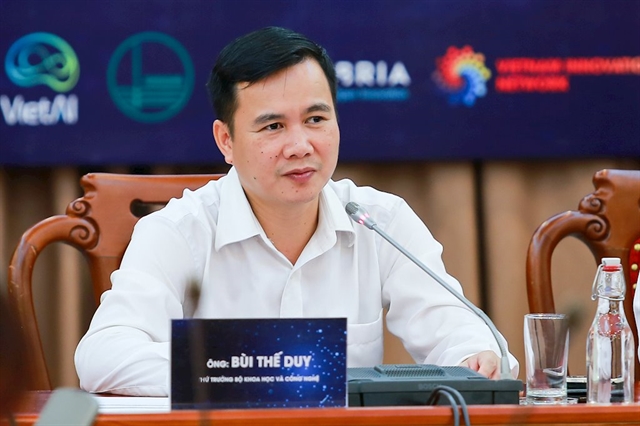 Economy
Economy


|
| Bùi Thế Duy |
Artificial intelligence (AI) is one of key technologies of the Fourth Industrial Revolution and impacts all aspects of society. Bùi Thế Duy, deputy minister of Science and Technology, spoke to various media outlets about the role of AI in Việt Nam.
Could you tell us about the role of AI in Việt Nam?
In Việt Nam, AI has been studied and developed at universities and institutes to resolve the country’s specific problems such as writing, Vietnamese language, and understanding and analysing Vietnamese texts. In the current context of Industry 4.0 which is taking place strongly in Việt Nam, AI is considered a core technology. It has been applied in many key socio-economic sectors such as healthcare, education, business, trade, finance and agriculture. The development of AI in many countries has been considered an inevitable trend and Việt Nam is no different.
What are the advantages and difficulties for AI development in Việt Nam?
Việt Nam has good pre-conditions for access to high technologies, new knowledge and outstanding development opportunities. There is a young population and many more people are interested in new technologies and higher education than in previous generations. In addition, information, technology and communications in Việt Nam have had strong development in the past few years, creating a stable IT infrastructure and internet network. These have the first steps to create a position for the nation in the international arena. These are important pre-conditions to bring AI applications to develop at a larger scale for a sustainable AI economy.
However, we are facing difficulties in developing AI due to the lack of Big Data, strong resources and businesses operating in AI. I hope we can evoke patriotism and nationalism as well as sharing data to build AI and Big Data.
It is crucial to build and share Big Data to develop AI. How is this issue being tackled in Việt Nam?
If you want to have AI products, you must have Big Data. Businesses that took years to solve the problem of collecting aggregate data from many sources, such as social network behaviour, consumer behaviour and repayment history. Some firms have to spend a large amount of money to buy data from others to have data in the fastest way. The current shortcoming of Việt Nam is there is no open data sharing among businesses to develop together. On the other hand, how to balance the development of new technologies such as AI and user privacy when sharing data also raises problems for managers.
To resolve the issue of Big Data, the 'Digital Vietnamese knowledge system' project – an ambitious Wikipedia-like portal tailored for Vietnamese was launched in Hà Nội on January 1. The Ministry of Science and Technology is in charge of the project. This has been an overall project, integrating different data sources to serve AI development. The amount of open data collected is huge and continuously increasing.
AI development in Việt Nam needs three key pillars of the State, businesses and scientists. How can we gather all three resources to create products suitable for Việt Nam?
The ministry has set a target of studying and developing technologies and applications to create some specific products. These studies aim to promote the research implementation at institutes and universities ordered by enterprises, with the support of the Government. Institutes and universities will improve research capacity while businesses will receive and develop products. We also aim to build and share computing capacity to have a shared machine system. Some key institutes and universities will be equipped with the system.
Currently, the ministry is working with key AI experts to work together to identify and implement priority tasks. We are also working with ministries and agencies to co-ordinate and implement programmes. We expect to have real and suitable steps with Việt Nam’s conditions to make AI development plans feasible and meet targets. In addition, the ministry has also regularly held events to connect relevant parties in the AI ecosystem and is paying attention to human resource training, developing infrastructure, machines and technologies to catch up with the world development trend.
People say AI research is very expensive. Is this just a playground for big corporations? Will small-and-medium enterprises (SMEs) have a chance to get involved in this research?
There are two ways to develop AI. One way is to have strong investment. However, there is another way by building specific applications and data resources. If we have strong determination and data sharing, we could create start-ups which have the world’s leading application in AI. Meanwhile, big corporations can focus on their strengths. We have many issues to resolve. This not only a challenge but also an advantage for the country to have a market for businesses’ development. — VNS




